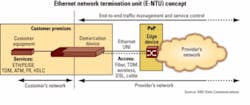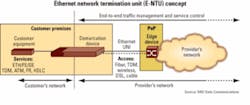Media converters evolve, get ‘smarter’
By Meghan Fuller
The simplest of media converters has long been a childhood favorite: two tin cans connected by a length of string or wire. This primitive “telephone” can be classified as a media converter because it takes an audio wave, converts it to mechanical movement, and converts that mechanical movement back to an audio wave. This process, however simplified, gets to the heart of media conversion technology: It changes the media, whether from fiber to copper or multimode fiber to singlemode fiber, etc.
However, a new class of intelligent media converters has emerged that doesn’t really comprise media converters at all; the devices simply contain media conversion technology as one of myriad functions. While the fundamental building block of the media converter-media in, media out-still exists, today’s devices have morphed into something more akin to a low-end router or Ethernet demarcation device.
“If you imagine the seven-layer OSI model, you discover that what once was just a physical-layer media converter has slowly made its way up the protocol stack,” explains Carl Gabrielson, director of product development at IMC Networks (www.imcnetworks.com). “Some of the media converters are actually doing things at Layer 4, performing some of the functions that low-end routers are doing,” he notes.
Eitan Schwartz, vice president of pseudowire and access technology at RAD Data Communications (www.rad.com), argues that these intelligent media converters now can be classified as Ethernet demarcation devices. Ethernet demarcation, he says, is actually a superset of media conversion.
The media converter or demarcation device usually is owned by the carrier, and it marks the point where the provider’s network ends and the customer’s network begins (see figure). “That could be a fiber interface,” says Schwartz, “but the carrier may actually have a TDM interface or a wireless or a DSL or a cable-any kind of interface-and he wants to convert from that kind of media to whatever service he is giving the customer. That could be Ethernet, Fast Ethernet, Gigabit Ethernet, ATM, Frame Relay. And it could be over copper or fiber,” he adds.
Now that carriers are delivering Ethernet-based services, they must offer service-level agreements (SLAs) that are comparable to traditional TDM services, which means they need a way to manage and monitor the Ethernet link remotely from the central office (CO). But Schwartz is quick to note that service providers do not want to deploy multiple boxes at the customer premises; therefore, the Ethernet demarcation box must include both the management and the media conversion technology.
And the new generation of media conversion/Ethernet demarcation device does just that. It supports all the intelligence needed to meet and verify the contractual obligations of a given class of service, including bandwidth allocation, traffic classification and prioritization, and rate limiting as well as diagnostics and maintenance. Off-loading these tasks to the Ethernet demarcation device improves the efficiency of the core router. Moreover, the reduction in truck rolls that results from having remote management, remote diagnostics, remote provisioning, and remote control lowers the service provider’s operational expenditures.
Intelligent media converters enable service providers to prioritize one traffic type over another. Perhaps an enterprise customer specifies that the traffic that is transported between two locations or branches should take precedence over basic Internet access. The media converter can be remotely configured to give a certain traffic type priority while the other is simply “best effort.”
Using a basic, unmanaged media converter, each customer would get the amount of bandwidth on the line, regardless of whether the customer wanted to pay for that bandwidth or not. But the new intelligent devices enable rate limiting; the media converter will only transmit the amount of bandwidth the customer requires, say 5 Mbits/sec rather than 100 Mbits/sec or Gigabit Ethernet.
Double VLAN tagging or queue-in-queue is another key capability, says Bill Schultz, vice president of marketing at Transition Networks (www.transition.com). A double tag or queue-in-queue allows the customer to attach its specific VLAN identification, which the service provider then encapsulates within its own tag. The service provider can route the traffic through its network, then strip off its tag before handing the traffic off to the customer, with the customer’s VLAN identification intact.Built-in OAM functionality provides all the information necessary to determine SLAs. What is the latency of the link? What is its jitter? What are the availability and the packet loss? “Last gasp” capability enables the converter to sense a power loss at the remote premises and send an alarm message back to the CO.
Media converters also provide RMON statistics or information about the data channel, including the size and number of sent packets as well as the number of errored packets. This information is useful to both service provider and customer to verify that the customer actually received the service for which it was billed.
Tim Smith, optical product specialist at MRV Communications (www.mrv.com), agrees with Schwartz’s contention that today’s converters are much evolved. “The lines of delineation between media converters and other systems are a bit grayed,” he admits. Moreover, he reports that today’s intelligent converters can metamorphose into “a different beast.”
Say, for example, an enterprise has established a point-to-point circuit between two of its premises using dedicated fiber and media converters to interconnect those premises. Now say the enterprise needs to provision an additional service along that span. Should the enterprise remove those converters and install an upscale DWDM system? The answer, says Smith, is “not necessarily.” The enterprise can turn those existing converters into WDM transponders simply by plugging in colored WDM optics or SFPs.
“You’re still using the same base platform,” Smith confirms, “and you’re still using the same management attributes that are in that converter. All you’ve done is change the color and perhaps add some additional optical multiplexers in front of it. The model is to be able to reuse as much of the technology as possible.”
Transition Networks’ Schultz agrees, adding that SFPs allow service providers to reap the full benefits of CWDM technology, which, like DWDM, enables them to get more capacity out of their existing fiber but at a lower cost. “You simply pop in an SFP with a certain nanometer wavelength or color, and then you can mux that over passive CWDM optics,” muses Schultz. “You use one strand of fiber to get many connections across.”
The use of SFPs, in fact, has been instrumental in facilitating the flexibility and modularity of media conversion technology. Imagine a common converter platform, a basic black box with two SFP receptacles, says Smith. You can choose from more than 100 different media types and reach requirements and populate the box with SFPs that fit your needs. That basic box now is capable of supporting virtually any protocol, either over copper or fiber. You don’t need to de-provision any equipment, he says. You simply change the least common items, which are the SFPs themselves.
Gabrielson reports that IMC Networks sells a basic, nonmanaged media converter that does mode conversion. “Literally,” he says, “you come in at one lambda and convert it to another.” Say you have a SONET device running inexpensive 850-nm multimode optics. You can plug an 850-nm multimode SFP into the converter on one side and then plug in a 1,550-nm singlemode SFP on the other side. “So the SONET equipment can use the lowest-cost optics, yet you can still get 80-km distance,” says Gabrielson. “It’s a real nice value proposition.”
SFP optics also include diagnostic management information (DMI) that enables service providers to measure key performance parameters of the optical link and the laser itself, including transmit and receiver power, bias current, and temperature.
Perhaps the real beauty of these intelligent media converters is their price points; by all accounts, the small incremental price premium of the intelligent devices is more than offset by the benefits they provide. “They literally can tell you when something is wrong in a proactive sense and then facilitate troubleshooting of the line without [the technician] getting in a truck and driving out to see what is wrong,” reiterates Gabrielson. “That’s where just one truck roll will save the extra cost of getting the management in these things. The value proposition is just there.”
The media converter manufacturers can offer their devices at a lower cost thanks to innovation in the component space. Fifteen years ago, a six-port switch cost $20,000, says Gabrielson. Today, he can buy a six-port switch on a $10 piece of silicon. “Once you start getting all this functionality in a little piece of silicon, you can put an application layer around that silicon and adapt it to all kinds of incredible products,” he notes. “It’s just exploding.
In fact, argues Gabrielson, intelligent media conversion technology today is only limited by the industry’s perception of it. “A lot of customers haven’t seen the value-added proposition yet,” he admits, “but once they start seeing it, it’s going to become more and more obvious. The more functionality we put in these things, the wider our customer base becomes.”Meghan Fuller is senior editor at Lightwave.

